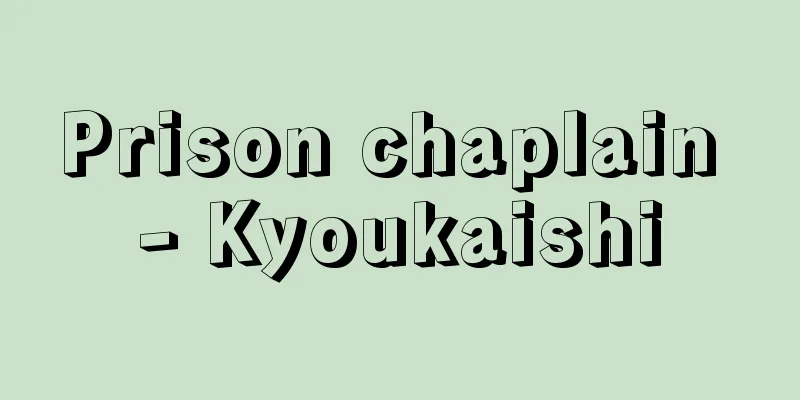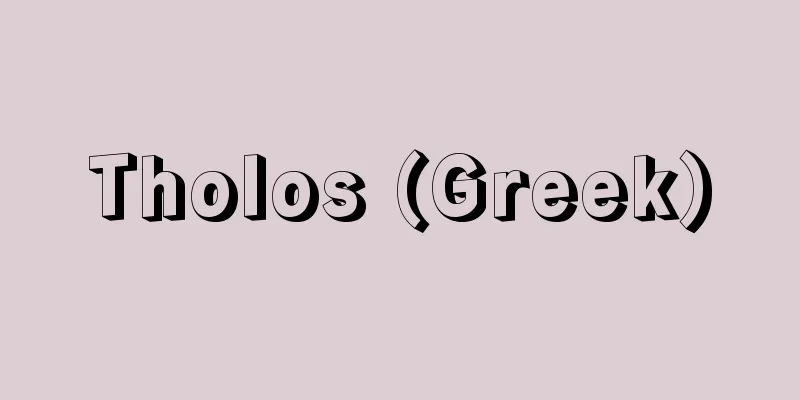Prison chaplain - Kyoukaishi

|
A person who preaches to prisoners in prison on how to repent of their mistakes and cultivate virtue. In most cases, religious leaders are appointed to this role. In Japan, many Shinshu monks serve as such. It began in 1872 (Meiji 5), when Gomyo-ji Taigaku of the Shinshu Otani sect applied to the Ministry of Education for prisoner instruction after serving his term as chief priest, and began providing instruction to prisoners. The views of the administrative authorities on prisoner instruction can be seen in the 1881 Prison Regulations, which state, "Prison chaplains shall be appointed to teach convicts and those on administrative leave to teach them the path to repentance and righteousness," and in a notice sent to prefectural governors by Home Minister Yamagata Aritomo in August 1885, which called for a punitive approach that would impose the hardship of disciplinary hardship rather than instruction. In this historical context, the Otani-ha and Honganji-ha Shinshu sects focused their efforts on establishing institutions to train chaplains and on prison instruction between 1882 and 1899. The contents of the prisoner instruction by the monks were the teachings on the four principles of gratitude, the two truths of the true and the secular, and karma. According to the National Federation of Prison Chaplains, the number of Buddhist chaplains was 1,202 out of 1,840 nationwide, or 65% (as of January 2019), which is a higher rate than other religions. [Hidetoshi Ikeda] "The History of Prison Instruction in Japan, Vol. 1 and 2, compiled by the Honganji Otani School (1900, Hozokan)" ▽ "Research on the Social History of Modern Japanese Buddhism, by Yoshida Hisakazu (1964, Yoshikawa Kobunkan)" ▽ "Sugamo Prison, by Kobayashi Hirotada (Chuko Shinsho/Chuko Bunko)" [Reference] |Source: Shogakukan Encyclopedia Nipponica About Encyclopedia Nipponica Information | Legend |
|
刑務所において、服役中の囚人に対して、過ちを悔い改め徳性を養うための道を説く者。多くは宗教家がこれに任ぜられる。日本ではとくに真宗の僧が多く行っている。1872年(明治5)真宗大谷派仰明寺対岳(ごうみょうじたいがく)が、管長を経て教部省へ囚徒教誨を出願し、教誨を開始したことに始まる。囚徒教誨に対する行政当局の見解は、1881年の「監獄則」に「已決囚(いけつしゅう)及ビ懲治人(ちょうじにん)教誨ノ為メ教誨師ヲシテ悔過遷善(げかせんぜん)ノ道ヲ講ゼシム」とあるような教化主義や、1885年8月内務卿山県有朋(やまがたありとも)が府県長官にあてた通達のなかの、教誨訓導よりも懲戒駆役(ちょうかいくえき)の労苦を課す懲罰主義の要請などにみることができる。このような歴史的情況のなかで真宗大谷派と本願寺派は、1882年から1899年にかけて教誨師養成機関の整備と監獄教誨に力を注いだ。僧侶(そうりょ)の囚徒教誨内容は、四恩報謝(しおんほうしゃ)、真俗二諦(しんぞくにたい)、因果応報(いんがおうほう)の教説であった。全国教誨師連盟によると、仏教系の教誨師数は、全国教誨師数1840人中1202人、65%(2019年1月時点)で、他宗教に比して高い率を示している。 [池田英俊] 『本願寺大谷派編『日本監獄教誨史』上下(1900・法蔵館)』▽『吉田久一著『日本近代仏教社会史研究』(1964・吉川弘文館)』▽『小林弘忠著『巣鴨プリズン』(中公新書/中公文庫)』 [参照項目] |出典 小学館 日本大百科全書(ニッポニカ)日本大百科全書(ニッポニカ)について 情報 | 凡例 |
>>: "Ecclesiastical History" (Sozomenos) - Ecclesiastical History
Recommend
IEA - International Energy Agency
International Energy Agency. An organization under...
Hanshichi Torimonochō - Hanshichi Torimonochō
Kidō Okamoto's reading novels. Starting with ...
Hippocampal formation
… In humans, the hippocampus spreads along the ba...
Maximianus, Marcus Aurelius Valerius
[Raw] 240? Sirmium [Died] 310. Massilia, Roman Emp...
"Kamisuki jusan ne" - Kamisuki jusan ne
...A play on the second-grade Handayu. (b) An abb...
Continued Kyogen
〘 noun 〙 In contrast to the one-act hanare kyogen ...
Dish night (English spelling)
The term "program picture" was also coi...
Ogura Seizaburou - Ogura Seizaburou
1882-1941 A sexologist and philosopher from the T...
"Gyokuyoshu" - Gyokuyoshu
…It was compiled by Kyogoku Tamekane in 1312 (Sho...
Pavol Josef Šafárik
1795‐1861 Slovak scholar and poet. In Czech, his n...
Wage Rudolf Supratman
1903‐38 He wrote the lyrics and composed the Indon...
(■1)∥Kiiro - Colorful
A word that has been widely used since ancient tim...
Beaucarnea recurvata (Nolina recurvata) - Beaucarnea recurvata (English name)
A small tree of the Agavaceae family. Native to Me...
Arianism - Arianism
An ancient Christian heresy named after its propo...
Kaga Ikko Ikki
From 1474 (Bunmei 6) to 1580 (Tensho 8), the Ikko...



![Higashiyoshino [village] - Higashiyoshino](/upload/images/67cc99e12c67c.webp)


![Irakli [II] - Irakli](/upload/images/67cf728db8ecb.webp)


